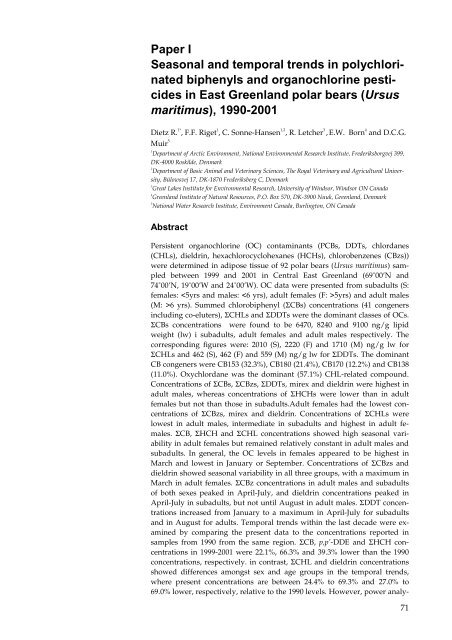Organohalogen concentrations and a gross and histologic ...
Organohalogen concentrations and a gross and histologic ...
Organohalogen concentrations and a gross and histologic ...
Create successful ePaper yourself
Turn your PDF publications into a flip-book with our unique Google optimized e-Paper software.
Paper I<br />
Seasonal <strong>and</strong> temporal trends in polychlorinated<br />
biphenyls <strong>and</strong> organochlorine pesticides<br />
in East Greenl<strong>and</strong> polar bears (Ursus<br />
maritimus), 1990-2001<br />
Dietz R. 1*<br />
, F.F. Riget 1<br />
, C. Sonne-Hansen 1,2<br />
, R. Letcher 3<br />
, E.W. Born 4<br />
<strong>and</strong> D.C.G.<br />
Muir 5<br />
1<br />
Department of Arctic Environment, National Environmental Research Institute, Frederiksborgvej 399,<br />
DK-4000 Roskilde, Denmark<br />
2<br />
Department of Basic Animal <strong>and</strong> Veterinary Sciences, The Royal Veterinary <strong>and</strong> Agricultural University,<br />
Bülowsvej 17, DK-1870 Frederiksberg C, Denmark<br />
3<br />
Great Lakes Institute for Environmental Research, University of Windsor, Windsor ON Canada<br />
4<br />
Greenl<strong>and</strong> Institute of Natural Resources, P.O. Box 570, DK-3900 Nuuk, Greenl<strong>and</strong>, Denmark<br />
5<br />
National Water Research Institute, Environment Canada, Burlington, ON Canada<br />
Abstract<br />
Persistent organochlorine (OC) contaminants (PCBs, DDTs, chlordanes<br />
(CHLs), dieldrin, hexachlorocyclohexanes (HCHs), chlorobenzenes (CBzs))<br />
were determined in adipose tissue of 92 polar bears (Ursus maritimus) sampled<br />
between 1999 <strong>and</strong> 2001 in Central East Greenl<strong>and</strong> (69˚00’N <strong>and</strong><br />
74˚00’N, 19˚00’W <strong>and</strong> 24˚00’W). OC data were presented from subadults (S:<br />
females: 6 yrs). Summed chlorobiphenyl (ΣCBs) <strong>concentrations</strong> (41 congeners<br />
including co-eluters), ΣCHLs <strong>and</strong> ΣDDTs were the dominant classes of OCs.<br />
ΣCBs <strong>concentrations</strong> were found to be 6470, 8240 <strong>and</strong> 9100 ng/g lipid<br />
weight (lw) i subadults, adult females <strong>and</strong> adult males respectively. The<br />
corresponding figures were: 2010 (S), 2220 (F) <strong>and</strong> 1710 (M) ng/g lw for<br />
ΣCHLs <strong>and</strong> 462 (S), 462 (F) <strong>and</strong> 559 (M) ng/g lw for ΣDDTs. The dominant<br />
CB congeners were CB153 (32.3%), CB180 (21.4%), CB170 (12.2%) <strong>and</strong> CB138<br />
(11.0%). Oxychlordane was the dominant (57.1%) CHL-related compound.<br />
Concentrations of ΣCBs, ΣCBzs, ΣDDTs, mirex <strong>and</strong> dieldrin were highest in<br />
adult males, whereas <strong>concentrations</strong> of ΣHCHs were lower than in adult<br />
females but not than those in subadults.Adult females had the lowest <strong>concentrations</strong><br />
of ΣCBzs, mirex <strong>and</strong> dieldrin. Concentrations of ΣCHLs were<br />
lowest in adult males, intermediate in subadults <strong>and</strong> highest in adult females.<br />
ΣCB, ΣHCH <strong>and</strong> ΣCHL <strong>concentrations</strong> showed high seasonal variability<br />
in adult females but remained relatively constant in adult males <strong>and</strong><br />
subadults. In general, the OC levels in females appeared to be highest in<br />
March <strong>and</strong> lowest in January or September. Concentrations of ΣCBzs <strong>and</strong><br />
dieldrin showed seasonal variability in all three groups, with a maximum in<br />
March in adult females. ΣCBz <strong>concentrations</strong> in adult males <strong>and</strong> subadults<br />
of both sexes peaked in April-July, <strong>and</strong> dieldrin <strong>concentrations</strong> peaked in<br />
April-July in subadults, but not until August in adult males. ΣDDT <strong>concentrations</strong><br />
increased from January to a maximum in April-July for subadults<br />
<strong>and</strong> in August for adults. Temporal trends within the last decade were examined<br />
by comparing the present data to the <strong>concentrations</strong> reported in<br />
samples from 1990 from the same region. ΣCB, p,p’-DDE <strong>and</strong> ΣHCH <strong>concentrations</strong><br />
in 1999-2001 were 22.1%, 66.3% <strong>and</strong> 39.3% lower than the 1990<br />
<strong>concentrations</strong>, respectively. in contrast, ΣCHL <strong>and</strong> dieldrin <strong>concentrations</strong><br />
showed differences amongst sex <strong>and</strong> age groups in the temporal trends,<br />
where present <strong>concentrations</strong> are between 24.4% to 69.3% <strong>and</strong> 27.0% to<br />
69.0% lower, respectively, relative to the 1990 levels. However, power analy-<br />
71

















